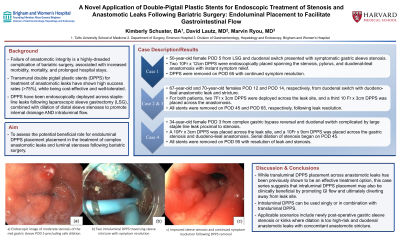Back


Poster Session A - Sunday Afternoon
Category: Interventional Endoscopy
A0446 - A Novel Application of Double-Pigtail Plastic Stents for Endoscopic Treatment of Stenoses and Anastomotic Leaks Following Bariatric Surgery: Endoluminal Placement to Facilitate Gastrointestinal Flow
Sunday, October 23, 2022
5:00 PM – 7:00 PM ET
Location: Crown Ballroom

Has Audio

Kimberly F. Schuster, BA
Tufts University School of Medicine
Boston, MA
Presenting Author(s)
Kimberly F. Schuster, BA1, David Lautz, MD2, Marvin Ryou, MD3
1Tufts University School of Medicine, Boston, MA; 2Emerson Hospital, Concord, MA; 3Brigham & Women's Hospital, Boston, MA
Introduction: Transmural double pigtail plastic stents (DPPS) for treatment of anastomotic leaks have shown high success rates ( >75%), while being well-tolerated and cost-effective. For example, DPPS can be endoscopically deployed across staple-line leaks following laparoscopic sleeve gastrectomy (LSG), often combined with dilation of distal sleeve stenoses or kinks. The rationale for this combination treatment is to promote internal drainage AND intraluminal flow. However, there may also be a beneficial role for endoluminal DPPS placement in the treatment of complex anastomotic leaks and luminal stenoses. We present a series of four patients with complicated post-bariatric anatomy successfully managed with endoluminal DPPS placement.
Case Description/Methods: Patient 1: 50-year-old female POD5 from LSG and duodenal switch presented with symptomatic gastric sleeve stenosis. Dilation was considered too high-risk. Two 10Fr x 12cm DPPS were endoscopically placed spanning the stenosis, pylorus, and duodenal-ileal anastomosis with instant symptom relief. DPPS were removed on POD65 with continued symptom resolution.
Patients 2 and 3: 67-year-old and 70-year-old females POD12 and 14, respectively, from duodenal switch with duodeno-ileal anastomotic leak and stricture. Two 7Fr x 3cm DPPS were deployed across the leak site. A third 10Fr x 3cm DPPS was placed across the anastomosis. All stents were removed on POD45 and POD65, respectively, following leak resolution.
Patient 4: 34-year-old female POD3 from complex gastric bypass reversal and duodenal switch complicated by large staple line leak proximal to stenosis. A 10Fr x 3cm DPPS was placed across the leak site. A 10Fr x 9cm DPPS was placed across the gastric stenosis and duodenal-ileal anastomosis. Serial dilation of stenosis began on POD45. All stents were removed on POD95 with resolution of leak and stenosis.
Discussion: Transluminal DPPS placement across anastomotic leaks is an effective, well-tolerated, and cost-effective treatment option. This case series suggests that intraluminal DPPS placement may also be clinically beneficial by promoting GI flow and ultimately diverting away from the leak site. Intraluminal DPPS can be used singly or in combination with transluminal DPPS. Applicable scenarios include newly post-operative gastric sleeve stenoses or kinks where dilation is too high-risk and duodenal anastomotic leaks with concomitant anastomotic stricture (where metal stent placement would be challenging and dilation likewise risky).

Disclosures:
Kimberly F. Schuster, BA1, David Lautz, MD2, Marvin Ryou, MD3. A0446 - A Novel Application of Double-Pigtail Plastic Stents for Endoscopic Treatment of Stenoses and Anastomotic Leaks Following Bariatric Surgery: Endoluminal Placement to Facilitate Gastrointestinal Flow, ACG 2022 Annual Scientific Meeting Abstracts. Charlotte, NC: American College of Gastroenterology.
1Tufts University School of Medicine, Boston, MA; 2Emerson Hospital, Concord, MA; 3Brigham & Women's Hospital, Boston, MA
Introduction: Transmural double pigtail plastic stents (DPPS) for treatment of anastomotic leaks have shown high success rates ( >75%), while being well-tolerated and cost-effective. For example, DPPS can be endoscopically deployed across staple-line leaks following laparoscopic sleeve gastrectomy (LSG), often combined with dilation of distal sleeve stenoses or kinks. The rationale for this combination treatment is to promote internal drainage AND intraluminal flow. However, there may also be a beneficial role for endoluminal DPPS placement in the treatment of complex anastomotic leaks and luminal stenoses. We present a series of four patients with complicated post-bariatric anatomy successfully managed with endoluminal DPPS placement.
Case Description/Methods: Patient 1: 50-year-old female POD5 from LSG and duodenal switch presented with symptomatic gastric sleeve stenosis. Dilation was considered too high-risk. Two 10Fr x 12cm DPPS were endoscopically placed spanning the stenosis, pylorus, and duodenal-ileal anastomosis with instant symptom relief. DPPS were removed on POD65 with continued symptom resolution.
Patients 2 and 3: 67-year-old and 70-year-old females POD12 and 14, respectively, from duodenal switch with duodeno-ileal anastomotic leak and stricture. Two 7Fr x 3cm DPPS were deployed across the leak site. A third 10Fr x 3cm DPPS was placed across the anastomosis. All stents were removed on POD45 and POD65, respectively, following leak resolution.
Patient 4: 34-year-old female POD3 from complex gastric bypass reversal and duodenal switch complicated by large staple line leak proximal to stenosis. A 10Fr x 3cm DPPS was placed across the leak site. A 10Fr x 9cm DPPS was placed across the gastric stenosis and duodenal-ileal anastomosis. Serial dilation of stenosis began on POD45. All stents were removed on POD95 with resolution of leak and stenosis.
Discussion: Transluminal DPPS placement across anastomotic leaks is an effective, well-tolerated, and cost-effective treatment option. This case series suggests that intraluminal DPPS placement may also be clinically beneficial by promoting GI flow and ultimately diverting away from the leak site. Intraluminal DPPS can be used singly or in combination with transluminal DPPS. Applicable scenarios include newly post-operative gastric sleeve stenoses or kinks where dilation is too high-risk and duodenal anastomotic leaks with concomitant anastomotic stricture (where metal stent placement would be challenging and dilation likewise risky).

Figure: a) Endoscopic image of moderate stenosis of the mid gastric sleeve POD 5 precluding safe dilation; b) two intraluminal DPPS traversing sleeve stricture with symptom resolution ; c) improved sleeve stenosis and continued symptom resolution following DPPS removal
Disclosures:
Kimberly Schuster indicated no relevant financial relationships.
David Lautz indicated no relevant financial relationships.
Marvin Ryou: Boston Scientific – Consultant. Cook – Consultant. EnteraSense – Consultant, Owner/Ownership Interest. Fuji – Consultant. GI Windows – Consultant, Owner/Ownership Interest. Olympus – Consultant.
Kimberly F. Schuster, BA1, David Lautz, MD2, Marvin Ryou, MD3. A0446 - A Novel Application of Double-Pigtail Plastic Stents for Endoscopic Treatment of Stenoses and Anastomotic Leaks Following Bariatric Surgery: Endoluminal Placement to Facilitate Gastrointestinal Flow, ACG 2022 Annual Scientific Meeting Abstracts. Charlotte, NC: American College of Gastroenterology.

